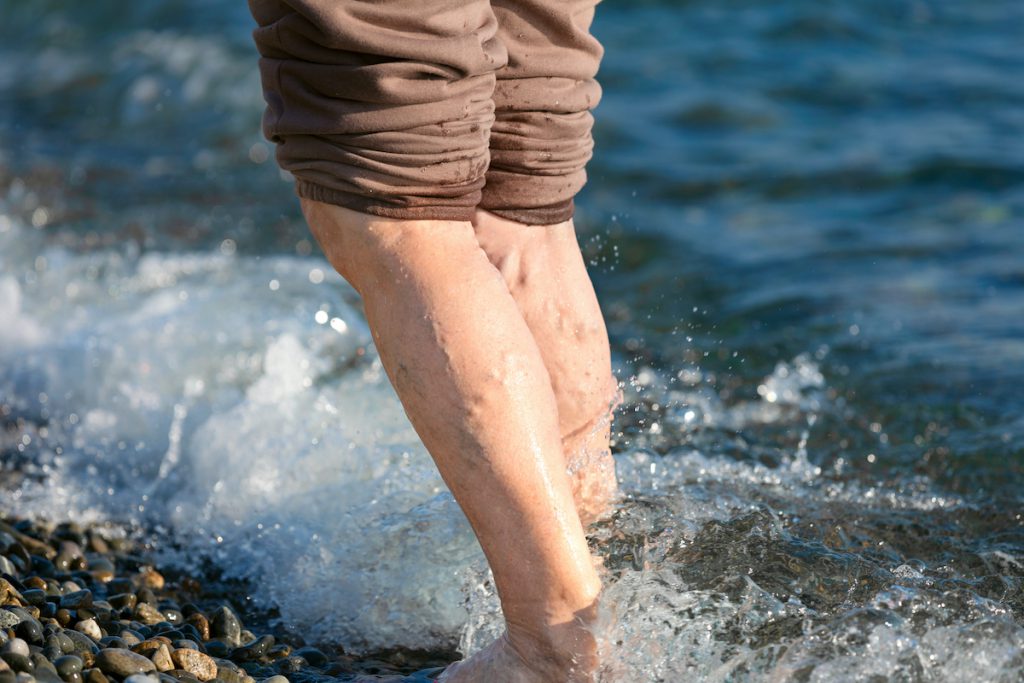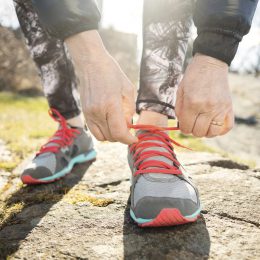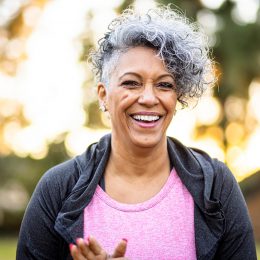Cómo deshacerse de las arañas vasculares y las venas varicosas
They can be unsightly, but when should you take action?

Your veins have an incredibly important job: They carry oxygen-rich blood and nutrients from the body back to your heart. But like many things in life, time can take a toll on your veins.
Getting older is a risk factor for developing thin, wispy veins that are visible through the skin, known as spider veins. Aging also can bring on larger, bulging veins, known as varicose veins. Both types often show up on your legs. Whichever you start to notice, the idea of getting rid of them can be appealing. But when should you take medical action and when should you leave them alone?
"I get a lot of referrals for patients who have spider veins or varicose veins," says William Marston, M.D. He's a professor in the division of vascular surgery at UNC School of Medicine in Chapel Hill, North Carolina. "They don't really bother the patient, but either their primary care physician or a family member has said something like, 'Oh, you ought to get those looked at.'"
Before we dive into why and how spider veins and varicose veins may be treated, here’s some helpful background.
What Are Spider Veins and Varicose Veins?
Both types are damaged veins. The damage happens when tiny, one-way valves inside your veins weaken. Instead of pushing blood toward your heart, some of the blood flows backward and builds up in the vein. The extra blood puts pressure on the walls of that vein, which can cause it to further weaken and bulge.
With spider veins, it’s often just a cosmetic concern: Most of the time, they’re asymptomatic and unsightly, but they’re not a real medical problem, Dr. Marston says.
Spider veins — which can be blue, purple, or red and appear as thin lines, webs, or branches — may also be caused by sunlight exposure, hormonal changes, or an injury, according to the American Academy of Dermatology (AAD).
Varicose veins are a deeper dilation of the vein, Dr. Marston says. They're not only larger and can appear more unsightly, but they can also cause pain and swelling. This can make it difficult to walk or maintain your normal activity levels. Some varicose veins can also raise your risk of blood clots.
The good news is that most varicose veins won’t become a problem in those over 65, Dr. Marston says.
"There's a lot of misinformation on the internet and elsewhere saying that you have to get your varicose veins fixed or they're going to cause a blood clot. But that's not true," Dr. Marston says. "We always talk to our patients about treating them based on how the leg is feeling and how it looks at that time. The idea that you're going to treat a varicose vein to prevent it from getting worse is not a well-proven concept."
To help decide what to do about your spider veins or varicose veins, Dr. Marston asks patients the following two questions:
- Are your spider or varicose veins causing any symptoms? Even large varicose veins can be asymptomatic, meaning you don’t have any symptoms. “If there’s no pain, the leg isn’t swelling, and you’re able to be active without heaviness or aching, then we leave them alone,” Dr. Marston says.
- Do you have a history of blood clots or other complications? A history of blood clots in a varicose vein may increase your risk of complications. If you answer yes, your doctor may want to discuss further examination or treatment options.
When to See Your Doctor
You should see your doctor or a vein specialist — and possibly consider treatment — if you have any of the following symptoms:
Significant pain. You may also have burning, throbbing, muscle cramping, or a feeling of heaviness in the leg.
Swelling in the leg. “It’s usually the ankle that swells first,” Dr. Marston says.
Bleeding from the vein. Vein bulges can become itchy, and when scratched they can easily bleed. Bleeding from varicose veins is a medical emergency, according to the National Heart, Lung, and Blood Institute. Seek help immediately if this happens.
Skin discoloration, called hyperpigmentation. “This usually occurs around the ankle area. It’s a brownish discoloration,” Dr. Marston says.
Skin scarring or thickening. These changes often occur between the ankle and lower calf, Dr. Marston says. “We look at that area pretty carefully to see if there are any changes that would indicate there’s more of a vein defect than just varicose veins.”
The severity of these symptoms will determine whether you need treatment to maintain mobility or reduce your risk of blood clots.
7 Treatment Options You Should Know About
There's a wide range of treatments for spider veins and varicose veins, from lifestyle changes to surgical procedures. Here are the primary options to consider and ask your doctor about:
Treatment Option #1: Lifestyle Changes
Certain habits can help improve circulation, such as maintaining a healthy weight, getting up to walk around every 30 minutes (or taking a break from standing every 30 minutes), and exercising regularly. These healthy habits won’t get rid of existing spider or varicose veins, but they can help prevent new ones.
Treatment Option #2: Compression Therapy
This treatment, which involves wearing compression socks, stockings, or bandages, applies steady pressure on the veins in the legs. It can help improve blood flow, reduce swelling, and lower the risk of blood clots. Compression therapy doesn't correct underlying damage, but it helps relieve symptoms and prevent further spider or varicose veins.
Your doctor can prescribe compression therapy as a stand-alone treatment or for use after a procedure (such as any of those below) to close or remove your damaged veins.
Treatment Option #3: Sclerotherapy
Sclerotherapy is one of the most common non-surgical procedures to treat both spider and varicose veins. It involves injecting a chemical directly into the affected vein. This irritates the walls of the vein, causing them to stick together so that blood can't flow through the vein anymore. This reduces swelling and causes the vein to shrink.
Spider veins usually disappear within three to six weeks, while varicose veins take three to four months. You may need several treatments to get your desired results.
A dermatologist, vascular surgeon, plastic surgeon, or a trained nurse can perform sclerotherapy treatments during an office visit - no anesthesia needed. You can return to your usual activity as soon as that day, but patients will need to wear compression stockings for several days or weeks after the procedure.
Treatment Option #4: Laser Treatment
This non-invasive procedure uses a laser to treat spider veins and very small varicose veins that are close to the skin's surface. The laser light is applied directly to the skin, closing and shrinking the vein below. The vein will eventually dissolve. Small spider veins may disappear immediately after treatment, while larger spider veins and varicose veins can take up to three months to completely clear up. You may need more than one treatment - scheduled every six to 12 weeks - for permanent results.
Most people can return to normal activities the same or next day. To prevent dark spots from forming, it's important to protect the treated area from the sun for three to four weeks after treatment, according to the AAD.
Treatment Option #5: Endovenous Laser Therapy (EVLT) or Radiofrequency Ablation (RFA)
EVLT and RFA are newer procedures often used instead of surgery to treat spider veins, small varicose veins, or larger varicose veins (RFA only). Both treatments involve making a small incision in the damaged vein and then inserting a tiny tube or catheter and applying heat in the vein using a laser fiber (for EVLT) or radiofrequency energy (for RFA). This causes the vein to collapse and seal off.
Before the procedure, your doctor will numb the area with a local anesthetic so that you don't feel any pain. Side effects may include bruising, mild numbness, pain, and skin discoloration. Rare but more serious complications include venous thromboembolism (blood clots in the veins) and skin burns. To help prevent complications, your doctor will recommend wearing compression stockings and taking daily walks.
Suscríbase a nuestro boletín informativo
Es rápido y fácil: Usted podría estar entre las 13 millones de personas elegibles.
¿Ya es miembro? Haga clic para descubrir nuestros más de 15,000 centros participantes.
Síganos
With both EVLT and RFA, it usually takes about one year for the treated vein to disappear. For best results, you may need more than one treatment.
Treatment Option #6: Surgery
The goal of surgery is to remove a damaged vein. It can be an effective treatment for varicose veins, particularly larger ones. But it's generally not recommended for people over 65 unless there's a serious issue, such as an aneurysm (a bulge in the wall of a blood vessel that can develop in an artery or vein, and possibly rupture).
That's because no surgery is completely free of risk. Complications from a surgical procedure can include infection, nerve damage, bruising, pain, and skin discoloration. If you're interested in learning more, talk to your doctor about whether a surgical procedure might be right for you.
Treatment Option #7: Medication
If varicose veins are causing you pain, your doctor may prescribe medication to help such as diosmiplex (Vasculera®). This is a specially formulated prescription medical food product for people with chronic venous disease (CVD).
Diosmiplex works by addressing the changes in your biochemical pathways that could lead to varicose and spider veins, edema, stasis dermatitis, or leg ulcers. Side effects can include headaches and lower gastrointestinal problems. As always, talk to your doctor to learn more and for help deciding whether medication might be right for you.
What Else Should You Know?
Even if it's not medically necessary, you may still want to remove spider veins or varicose veins for cosmetic reasons. That decision is up to you and your doctor, but here are six things to consider before you undergo medical treatment:
Surgical Procedures Aren’t Always a Permanent Fix. Even with treatment for varicose veins, there’s still a chance you’ll have future vein problems, Dr. Marston says. “About 20 to 30 percent of patients will develop new varicose veins over the next 10 years,” he says. “It’s a hereditary condition, and we are not able to stop that.”
Your Doctor Will First Recommend Lifestyle Changes. Medical procedures aren’t the first line of defense for non-urgent varicose veins. Medicare and most insurance companies require doctors to first try non-invasive approaches, Dr. Marston says. “We have to try things like exercise and compression stockings for three months before they’ll cover other procedures.”
You Might Have to Pay Out of Pocket. If your procedure is purely for cosmetic purposes, you’ll likely have to pay for that yourself. As with any medical procedure, it’s a good idea to call the number on the back of your insurance card in advance to confirm exactly what is (and isn’t) covered. That way, you’re less likely to get any surprise bills.
Problems in Deep Veins Can’t Always Be Treated. A fair number of people with vein issues have problems deep in the vein that can’t be treated with lasers or surgery, Dr. Marston says. “We can’t close off those deep veins, and we don’t have good therapies to correct that problem,” he says. “So for those patients, we usually treat with compression and other modalities.”
Find a Qualified Specialist. Various types of doctors can take care of vein issues, including dermatologists, vascular surgeons, and vascular medicine specialists. There’s a lot of marketing around vein issues, so it can be difficult to find good specialists, Dr. Marston says. He recommends asking your primary care doctor for a referral.
The AAD’s Find a Dermatologist tool is also a good resource. You can enter your ZIP code and use the “cosmetic dermatology” filter to find qualified dermatologists near you.
Get a Second Opinion. Don’t feel rushed to get any medical procedure done, Dr. Marston says. “When you go into a vein office, they often recommend procedures right away. Unless you’re having severe problems, you may want to get a second opinion.”
¡Tome en línea sus clases favoritas de SilverSneakers!
SilverSneakers members can access live fitness classes and wellness workshops through SilverSneakers LIVE. See the latest schedule and RSVP for classes here.
¿No es miembro? Si usted tiene un plan de Medicare, este puede incluir SilverSneakers sin costo adicional. Verifique su elegibilidad al instante aquí.





